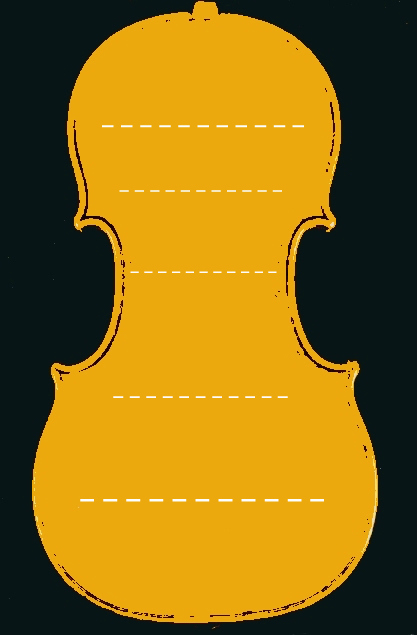A new more authentic approach to violin design
Back in August 2006 there was an article in The Strad magazine by Torbjörn Zethelius in which he presented an intriguing and highly convincing hypothesis on how violins might actually have been made by the Cremonese Masters.
In brief he suggested that they may well have hollowed the inside of the front and back plates before they worked on the outside. On the face of it this may not seem particularly remarkable although it has lead me on to a completely new approach to the shaping of the plates that, ironically, could well be much closer to the method used in the Golden Period by the Cremonese Masters.
Geometrical knowledge and application (a proportion based approach) was far stronger in this period in contrast to our more modern approach of measuring everything with unit measures. Unfortunately this has also lead to a more abstract work method, in modern times, that requires less understanding and is far less informative to the maker.
This may well be due to the fact that more modern violinmakers tend to just copy the arching of old instruments rather than develop their own model and, either if they do make their own model, they develop it from an old instrument rather than using the same methods as the old masters.
….. suggests that when the violin plates are hollowed, before they are worked on the outside, the precise curves of the hollowing can be guided by the use of a small, hanging chain. These are placed at 5 points across the arching of the front and back, in the middle of each bout and between the bouts across the upper and lower corner areas.

…. Also suggests the application of two diagonals following the chain’s curve, that form the cross diagonals of the largest rectangle that can fit within the middle C bouts. Regarding these diagonals I am less convinced. Not that they don’t work as I have made instruments following them and they work very well, only that of the instruments that I have measured (Cremonese Golden Period) few of them seem to follow this.
The hanging chain forms a natural and highly efficient curve called a Catenary Curve (Catena: Latin for chain). This curve had long been used in architectural design including buttresses for buildings such as Cathedrals. The buttress would be made upside down and a chain used to guide the mason to create this perfect Catenary Curved support.
From the many plans now available of the finest old instruments I have been able to compare the curves used to that of a perfect catenary, and have found that these instruments clearly follow these curves in an incredibly precise way. I decided that as the catenaries were indeed present then, strictly, they should follow the middle of the wood and not simply the internal curve, as the shape of any curved solid is defined by the line that bisects the outside and the inside of the curve. In practise it is an extremely marginal difference between the internal curve and the midline curve.

This shows part of the cross section of the front of the 1715 Titian Stradivari taken from the Narrow Point (ie the narrow part of the arching in the centre). The blue line is the catenary generated by the computer and the red line shows the midline between the outside surface and the interior. When you consider that the thickness of the front is less than 3mm it shows how closely the midline follows the catenary.
Drawing a Catenary with the computer I have found to be much more precise than holding a little chain. It also allows me to work with a catenary that follows the red line (middle of the wood).
One of the main benefits of this approach is that even when you have different thicknesses in the wood, compared to the one that is being copied, you can maintain the exact same structural shape by keeping the same midline. This is not possible using the standard modern approach of holding templates up to the outside of the arching (made from the outside arch of the one being copied).
I find it quite curious that many modern makers have invested a lot of time researching how to draw the outline of the instrument but very little has been done to analyse the arching, which is the power house of the tone generation. And what could be more important than that?
Another great benefit of this method is that it clearly reveals where there is distortion in the plates, that can happen over time. Often a bulge of one side will be countered by a sink on the other, and this can then be simply and accurately corrected.